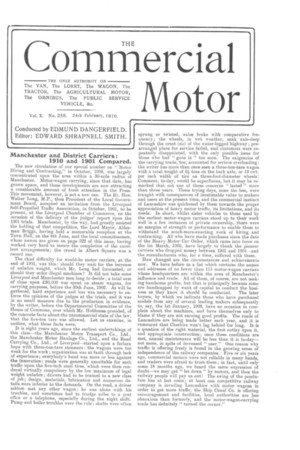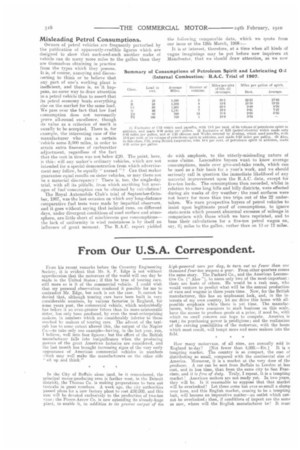Manchester and District Carriers: 1910 and 1901 Compared.
Page 1

Page 2

If you've noticed an error in this article please click here to report it so we can fix it.
The new circulation of our special number on " Motor Hiring and Contracting," in October, 1908, was largely concentrated upon the area within a 30-mile radius of Manchester. Motor-wagon carrying, since that date, has grown apace, and these developments are now attracting a considerable amount of fresh attention in the Press. This movement, however, is not a new one. The Rt. Hon. Walter Long, M.P., then President of the Local Government Board, accepted an invitation from the Liverpool Self-Propelled Traffic Association, in October, 1901, to be present, at the Liverpool Chamber of Commerce, on the occasion of the delivery of the judges' report upon the 1901 trials. Manchester, bv the way, had greatly assisted the holding of that competition, the Lord Mayor, Alderman Briggs, having held a memorable reception at the Town Hall, on the 4th June, and the local committeemen, whose names are given on page 522 of this issue, having worked very hard to insure the completion of the excellent arrangements; the crowd in Albert Square was a record one.
The chief difficulty for would-be motor carriers, at the end of 1901, was should they wait for the increase of unladen weight, which Mr. Long had forecasted, or should they order illegal machines? It did not take some Liverpool and Manchester men long to decide ; a total sum of close upon £30,000 was spent on steam wagons, for carrying purposes, before the 30th June, 1902. As will be gathered, hard experience and loss was necessary to enforce the opinions of the judges at the trials, and it was in no small measure due to the production in evidence, by the writer, before the Departmental Committee of the House of Commons, over which Mr. Hobhouse presided, of the concrete facts about the uncommercial state of the law, that the five-ton tare was allowed. Let us examine, in outline, what those facts were.
It is eight years ago, since the earliest undertakings of this class—the Manchester Motor Transport Co., Ltd. the Manchester Motor Haulage Co., Ltd., and the Roaci Carrying Co,. Ltd., of Liverpool—started upon a forlorn hope with three-ton-tare steamers: the wagons were too weak for the work ; organization was at fault through lack of experience; everybody's hand was more or less against the innovation ; roads were generally unsuitable for such traffic upon the five-inch steel tires, which were then rendered virtually compulsory by the low maximum of legal weight unladen ; drivers had to be trained to a new class of lob; design, materials, lubrication and numerous details were inferior to the demands. On the road, a driver seldom met any other wagon; • he was alone with his troubles, and sometimes had to trudge miles to a post -office or a telephone, especially during the night shift. Pump and boiler troubles were the rule ; shafts were often
sprung or twisted, axles broke with comparative frequency ; the wheels, in wet weather, sank axle-deep through the crust (sic) of the water-logged highway ; prearranged plans for service failed, and customers were repeatedly disappointed, with the only possible issue for those who had " gone in " too soon. The exigencies of the carrying trade, too, accounted for serious overloading : the writer has more than once seen a three-ton-tare wagon with a total weight of 64 tons on the back axle, or 13 cwt. per inch width of tire on three-foot-diameter wheels! Comment, to-clay, would be superfluous, but it may be remarked that not one of these concerns " lasted ' more than three years. Those trying days, none the less, were fraught with consequences of inestimable value to makers and users at the present time, and the commercial instinct of Lancashire was quickened by them towards the proper appreciation of heavy motor traffic, its limitations, and its needs. In short, whilst sister vehicles to those used by the earliest motor-wagon carriers stood up to their work well in a few instances of private ownership, there were no margins of strength or performance to enable them to withstand the much-more-exacting work of hiring and contracting. All who have made purchases since the date of the Heavy Motor Car Order, which came into force on the 1st March, 1905, have largely to thank the pioneer carriers who dropped money between 1901 and 190-1—and the manufacturers who, for a time, suffered with them.
How changed are the circumstances and achievements now. We have before us a list which contains the names and addresses of no fewer than 115 motor-wagon carriers whose headquarters are within the area of Manchester's influence and trade. All of them, of course, are not making handsome profits, but that is principally because some are handicapped by want of capital to conduct the business as they know it should be conducted. The later buyers, by which we indicate those who have purchased models from any of several leading makers subsequently to, say, the 1st January, 1908, have no occasion to complain about the machines, and have themselves only to blame if they are not earning good profits. The roads of Lancashire are being made better each year, and it is rumoured that Cheshire won't lag behind for long. It is a question of the right material, the first outlay upon it, and appropriate construction ; once these conditions are met, annual maintenance will be less than it is to-daynot more, in spite of increased " user." One reason why traffic is offering freely is found in the growing sense of independence of the railway companies. Five or six years ago, commercial motors were not reliable in many hands, and traders were afraid to trust them ; in fact, until only some 18 months ago, we heard the same expression of doubt—we may get " let down" by motors, and then the railway people will pay us out! The swing of the pendulum has at last come.; at least one competitive railway company is invading Lancashire with motor wagons in order to get more traffic, the Ship Canal Co. is offering encouragement and facilities, local authorities are less obnoxious than formerly, and the motor-wagon-carrying trade has definitely " turned the corner."
Misleading Petrol Consumptions.
Owners of petrol vehicles are frequently perturbed by the publication of apparently-credible figures which are designed to show That such-and-such another make of vehicle can do many more miles to the gallon than they are themselves obtaining in practice from the types which they poasess. It is, of course, annoying and disconcerting to think or to believe that any part of one's working plant is inefficient, and there is, as it happens, no surer way to draw attention to a petrol vehicle that: to assert that its petrol economy beats everything else on the market for the same load. We pass over the fact that low fuel consumption does not necessarily prove all-round excellence: though its value as a criterion of merit is usually to be accepted. There is, for example, the interesting case of the manufacturer who ran a certain 'vehicle some 3,000 miles, in order to attain extra fineness of carburetter adjustment, regardless of the fact that the cost in tires was not below £20. The point, here, is this: will any maker's ordinary vehicles, which are not intended for a special demonstration from which advertisement may follow, be equally " nursed " ? Can that maker guarantee equal results on sister vehicles, or may there not be a material discrepancy ? There is. too, the single-day trial, with all its pitfalls. from Which anything but averages of fuel 'consumption can be obtained by calculation!
The Royal Automobile Club's trial of September-October, 1907, was the last occasion on which any long-distance comparative fuel tests were made by impartial observers, and it goes without saying that isolated runs, on different days, under divergent conditions of road surface and atmosphere. are little short of mischievous qua consumptions-the lack of uniformity in wind resistances is by itself an influence of great moment. The R.A.C. report yielded
Class. Load in ewt, A 10
20
30 L) 40 E2 60 1F3 100
the following comparable data, which we quote from our issue ot the 12th March, 1908:— It is ot interest, therefore, at a time when all kinds of vague imaginings may be put before new inquirers at Manchester, that we should draw attention, as we now do with emphasis, to the utterly-misleading nature of some claims. Lancashire buyers want to know average consumptions, made over give-and-take roads, which can be used as a fair basis for a year's work, and we should seriously call in question the immediate likelihood of any material improvement upon the R.A.C. data, except for five-ton loads. The consumptions then recorded, whilst. in relation to some long hills and hilly districts, were effected during six weeks of dry weather: the road surfaces were not heavy for more than two trips out of the 22 undertaken. We warn prospective buyers of petrol vehicles to insist upon legitimate proof of consumptions, to ignore state.nents which present abnormal excesses of mileage in comparison with those which we have reprinted, and to base their calculations for a five-ton petrol wagon on, say, N. miles to the gallon. rather than on 10 01' 12 miles.








































